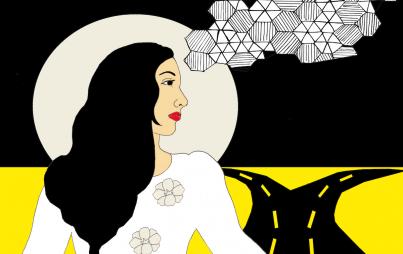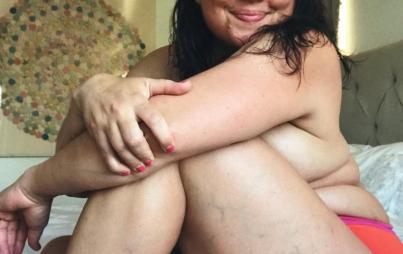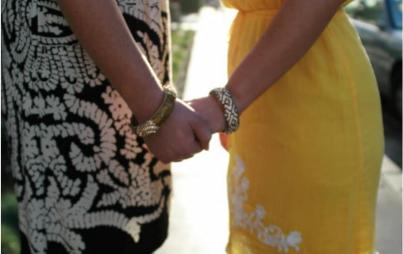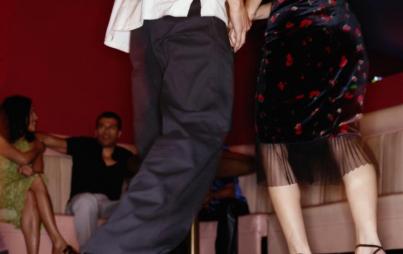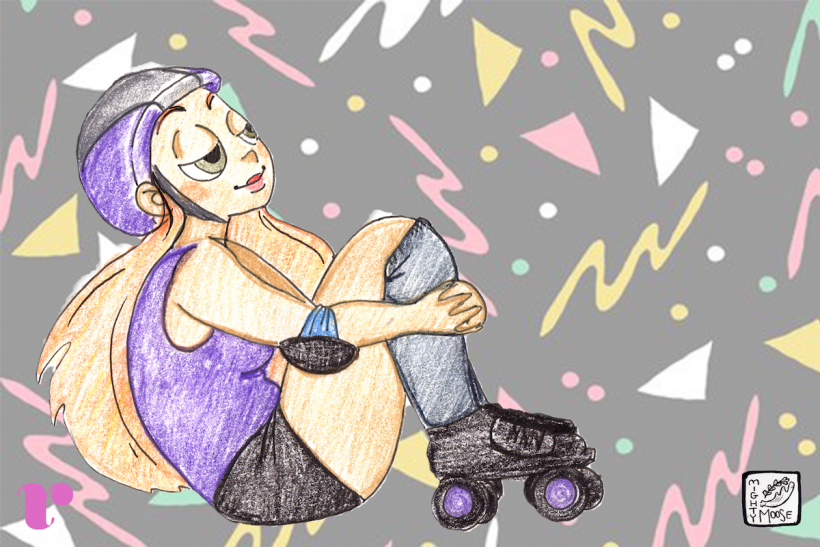
Image credit: Mariah Aro Sharp @mightymooseart
Long Reads is a bimonthly feature, showcasing long-form essays.
Roller derby saved my soul.
That phrase gets bandied around a bit in the sporting community.
I’d call roller derby an ‘alternative’ sport, but it’s now in almost every town and city, in most places both familiar and only vaguely remembered. It gets screened on ESPN. There are custom boots, wheels, bearings, spokespeople, and leagues popping up in schools and colleges, star players profiled in big name sporting publications. It’s Official.
Of course, it’s grown a lot in the ten years since I met the game. But then, so have I. Both figuratively and literally. Let me explain.
Once upon a time, I was a teenager. Awkard, gangly, uncomfortable in my skin. The usual adolescent stuff. Never at ease around people, I wanted desperately to work out how to be inside myself. But I had no idea where even to start. Restless, imaginative, I would pile myself into books, emerge dripping. They were a refuge and a life raft — other worlds where my own body did not seem to matter.
One thing snapped into focus: an artist recreated images of the sport she’d seen as a kid. It was sepia-tinted and chaotic; it was populated with women engaged wholly with each other. It was full of joy and full-bodied commitment. It was roller derby.
At some point, I thought that the restless energy, the discomfort in my own body could be contained in the same way that I’d tackled my academics. An A-student, I would apply myself, work out how subjects worked (economics required memorizing terminology definitions and using the same variables in differing orders, I quickly found) and then get the grade I needed. My body would work the same way, I was sure of it. Surely it must. Input, output — it seemed mathematical, mechanical, a miracle of modern or ancient engineering — I could work this out and contain it.
My diary became a chronicle of weight, a summary of food items, a list of exercises — a place for itemizing a particular kind of attempt at achievement. But it never worked out the way I thought it was supposed to. My body would never be disciplined the way I needed it to be. It needed things, got messy, had weight, too much weight, and always, always the discomfort.
My skin was an ill-fitting dress I couldn’t wait to shrug off at the end of the night.
Even then, sporting activities were strangely soothing to me. Sure, on some level they assuaged the pervading guilt in my adolescent life. But the chop-chop-chop of my hands as they split the water lap after lap had its own hypnotic rhythms that would lull me into my self-contained meditative space.
In retrospect, that was one of the few moments of respite I would get in a long and hectic day. Squeezed into a small apartment with my boisterous family, constantly talking over one another at the dinner table, then shuffled from staccato class to class and on to what seemed like endless extracurriculars, the water gifted me quiet and solitude — my own fleeting and waterlogged space.
And yet I was using it in a vain attempt to take up less space. Unsurprisingly, it didn’t work that way.
Many years later, my mother asked me “Is that why you never felt like you fitted in?” when I came out to her as queer. I giggled softly, and silently readied myself to become the Queer Educator she seemed to need. How easy that explanation sounded, though. Could I just will the explanation to be so simple, and then maybe it would be?
In the years to come, I would look for space again and again. This time as male desire would crush my body. At age 11, I discovered that public space was safe sometimes for other people, other bodies. I often wonder what that must feel like — to have space to daydream. My body, however, was up for comment, projecting desire upon, telling that it took up too much space, wasn’t worthy of regard if I didn’t seem interested, or worse, directly rejected.
Male friend after male friend would begin to get close, I would relax the carefully guarded space of my body towards them and then discover that they used terms like ‘friend zone’ about our relationship, poisoning the tentative ground between us. Leaving me acid-burned and full of bile, knowing again that my body was for consumption; to not hand it over on demand was to be punished, destroyed.
No one ever seems to ask the women left behind what it means to repeatedly be on the other side of the ‘friend zone’ — what it’s like to be told again and again that your person bears no value without your body on the line.
Some simply take what they consider their right to access. The crush of entitlement and gaslighting weighs heavily on this body that must always be slighter, slighted, slighting.
Somewhere in all that, I forgot how to find my own desire. The boys and men that were all around in public space, they claimed it everywhere, and my queerness got lost on the inside of that clamor. The wants and needs inside me got lost in the turmoil of feeling other people’s desires, flung against my brittle and damaged body. No water would let me anchor inside my own skin long enough to find an elsewhere.
If you’re one kind of player, a blocker, you stand your ground. On the track, your job is to create bridges, traps, walls. The wall became the most powerful commentary on the bounds of my body I’d ever been given. To step into being a wall, you ground yourself. You solidify. You reach for support. You inhabit space.
I thought that perhaps I could just discipline this body enough, and only then it would describe my contours in ways that could be good enough. My grades worked that way. Being a good daughter, sister, teammate did, too. If I could do those things so well, surely I could do this. Surely I could find out how to take up the right amount of space, and then it would be fixed.
On my high school swim team, no one sat us down and spoke about being an athlete and what it meant, how you should nourish yourself. The closest we came was a set of rules of Not-To-Eats. No fried food, no sodas. I had no trouble with that: my foods were scant, and those things had been ordered out of my life long before. No one mentioned to me that muscles need fuel to grow. That growing muscle and strength might be a good thing. That output out reflects input in. That I was an athlete. Or could have been. Might have been, had I found my body differently.
Unable to speak up and not knowing how to handle the comments, how to carve out the space I so sorely needed, the water was never quite enough. Lap after dogged lap, I would push myself for miles, my belly gnawing. My spare time became submerged in the library and the gym. It was easier always than the spaces where groups of other kids would gather. They were full of commentary and judgment, full of energy that I was focusing on diminishing in me.
I found sanctuary in keeping my head submerged and my calories down. There was never space for me outside those bounds.
Years collapsed behind me, I moved cities, exchanged place for place, and I would start to uncover fragments inside me that didn’t fit the narrowed-down space I had hitherto permitted. Or been permitted. My own needs began to show themselves, no matter what I did to hammer them down. Sometimes everything would stop for them to show themselves. I did all I could to jump-start back into productivity, to little avail.
Glimpses of other worlds would bring me back to myself in this: book fragments, art pieces. I read voraciously, book after book, and hunted down all the kinds of art I could find. At least, in those moments, I could focus outside myself when the calories and space of me could stretch to those things.
One thing snapped into focus: an artist recreated images of the sport she’d seen as a kid. It was sepia-tinted and chaotic; it was populated with women engaged wholly with each other. It was full of joy and full-bodied commitment. It was roller derby.
I knew then that I needed to find that.
And find it I did.
Roller derby is so many things. And there are so many differing ways to connect to it and be a part of the community. Suddenly, there were more people in my life, taking space, connecting with mine.
But this time, finding my space wasn’t about finding distance, or carving solitude, pushing away comments and clamor. Instead, it was relational.
It’s hard to clearly mark points in which everything changes, especially when you recognize how much abides. Strangely, through roller derby, they were the same thing. By finding the joy in the contours of my body colliding with others, I was able to listen to what was inside of me. Testing those boundaries in ways I wanted (what a change, to determine things that I wanted for my body outside of ‘less’), I found my own edges.
Roller derby is a team sport, a contact sport. To play it requires learning the bodies of other people physically.
The best kinds of teammates know the instinctive movements of the others they’re on the track with. They will seamlessly move into position, take on plays they’ve practiced into muscle memory.
It’s a sport defined by the people who play it. Which means it gets potentially more engaging and more safe with every iteration of rules — unique for sports that are usually decided for the players, the rules of the bodies on the line sketched out before they enter.
If you’re one kind of player, a blocker, you stand your ground. On the track, your job is to create bridges, traps, walls. The wall became the most powerful commentary on the bounds of my body I’d ever been given. To step into being a wall, you ground yourself. You solidify. You reach for support. You inhabit space.
I am a wall. I am a bridge. I am an immovable object.
To be submerged in a community that honors the strength in women is so quietly revolutionary that people almost don’t see the seismic shifts in it. Somewhere in my life, people stopped asking me to be small, to give, to be permeable. Instead, they asked me to connect, to hold my space, to take up more space — as much space as possible. They asked it for me, and for the team. I had the chance to respond to my teammates with taking the space I had chipped away at for so many years — to fill out, to fit it, fill it, overflow. To become solid. To be the wall.
It would be easy to talk about this as definitive: Here is this narrative of revolution. Everything is overturned. All is well in the world. “Roller derby saved my soul.”
But when a body expands to fill more space, while the world exerts external force upon it for it to get smaller, pressure inevitably builds.
It’s not the kind of regular everyday stressors like parking tickets or uneven sidewalks. It’s not a bad egg in the batch or a burnt taste on the cake you left in the oven just a few minutes too long. This kind of stress grinds at bones, compresses hearts and lungs. Leaves you tender and gasping for air.
Sometimes, when I go to put my clothes on, I realize that the hips and butt I’ve been building to do work for me on the track won’t fit inside the only casual professional wear I’ve got to ace that meeting. My heart pounds inside the walls of my chest. I try more clothing on, and none of it is right. I literally cannot fit into the necessities of this meeting this day, and that is its own admonishment: You are not doing adulthood correctly this day. This is not what being a productive member of society looks like. You have gone beyond yourself, expanded outside the acceptable. Get smaller again. Do it urgently.
Or I turn to meet my harasser, instinctively, like roller derby walls are built. Suddenly the memory of the piles of threat and fear seep into me like a shockingly frosted wave, beating the air from me, and I gasp. I stare into his eyes, and I see the potential for escalating violence right at the front of his corneas, and suddenly I’m scrambling for breath. I’m right in the middle of the speechless other in the ‘fight or flight’ duo — freeze.
The water weight of me freezes. I am a glacial monument to fear, petrified in my own daring, immobilized inside the daring to be solid, to take all that flagrant amount of space.
Each of the forces works their way on me. And sometimes I cannot withstand the pressure. I take brief breaks to rest and recover my energy. And then I always return.
Because before roller derby there was always too much of me. But with roller derby, there’s always exactly enough.
I am tangible, sweating, breathing. Inhaling the world, and pushing back into it. Roller derby may not have saved me, but now I inhabit myself in ways I had never previously dared to describe. And without it, I might have diminished beyond recognition. And that seems like enough.



